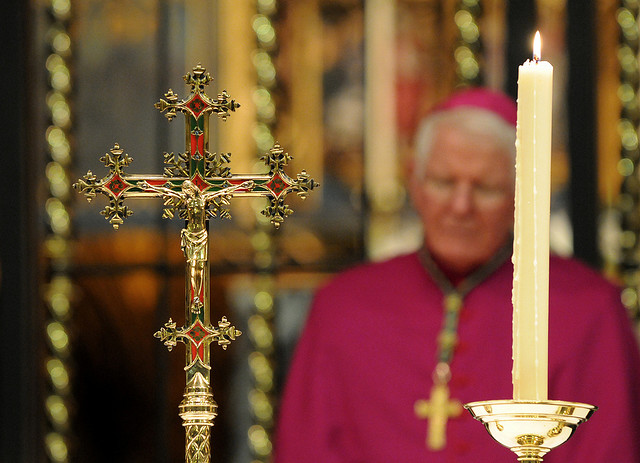Dear friends in Christ of the Diocese of Lancaster and beyond!
Welcome to this week’s Bishop’s Blog!
A busy and varied week has come to a close. Continuing my parish Visitation of St. Kentigern’s Deanery, Blackpool, I spent the weekend at Sacred Heart parish (under the shadow of the celebrated Blackpool Tower!), meeting the parishioners and visitors and celebrating the principal Mass.
The Sacred Heart church in view of its central location attracts many holiday visitors from different places, and it was a particular pleasure to exchange a few words with a number of them at the end of the Masses, and to admire their fidelity to the Lord when away from at Sunday Mass.
The friendliness and warmth of the people really lifted one’s spirits – it was a jot to be among them.
I also visited some housebound parishioners, and hopefully by my presence as Bishop reassuring them of their important place in the life of the Church.
On the Sunday night, I was invited for dinner with the Syro-Malabar Bishop – Mar Joseph Srampickal at St Alphonsa Cathedral House in Preston to celebrate his ‘name day – St Joseph.
It was good to hear first-hand of the progress and plans for the recently-established Syro-Malabar Eparchy for Great Britain and for me to able to express the prayers and support for Mar Joseph from the Diocese of Lancaster.
The church of St. Joseph, now part of St. John XXIII Parish in Preston, celebrated its patronal feast last Monday with a concelebrated Mass, at which I was joined by the resident priests and others from the city.
The Mass marked the culmination of a commendable nine-day novena in honour of St. Joseph and, apart from parishioners, there was an excellent attendance of children and staff from the five primary schools in the parish who had been extremely well prepared and catechised for the Mass.
The hard work of the priests, with the close cooperation of the schools, made for a wonderfully dignified celebration, and exemplified Catholic education at its best.
Particularly memorable was the confident rendering of the Panis Angelicus by two year six children during the Communion. How the author of the sacred piece, St. Thomas Aquinas, must have been smiling down from heaven!
I was particularly happy to bless, in the name of our local Church, the three new priests of the parish in their mission.
I pray, that through the powerful intercession of St Joseph, patron and guardian of the Universal Church, the mission, people and priests of St John XXIII Parish will be richly blessed.
Meanwhile, The Catholic Education Service organised a day on Wednesday in London for Bishops and others involved at diocesan level in Catholic Education. I was glad to be able to attend. It was a reflective time against the backdrop of recent trends and government initiatives in the field of education.
The challenges facing the Church in recruiting sufficient numbers of Catholic teachers, particularly at leadership levels, were acknowledged. Yet it was also felt to be a time of opportunity, despite the rapidity and far-reaching nature of change enveloping us.
The goal of teaching and handing on the Catholic faith must remain central to our Catholic schools whatever the patterns and format which will characterise education in coming years. This latter point, perhaps, was the overriding concern of the conference and well expressed in the concluding remarks of Cardinal Vincent Nichols – President of our Bishops’ Conference.
The Diocese of Brentwood marked the centenary of its foundation on Wednesday, one hundred years to the day that part of the East End of London and the county of Essex were taken from the archdiocese of Westminster to constitute the new diocese.
The Cathedral of Our Lady and St. Helen was full to capacity as, clergy, religious and faithful – with their bishops – joined in a Mass of Thanksgiving in the evening for a century of Catholic life as a diocesan family – even if shocked by the day’s terror attack in Westminster. We continue to pray for the victims!
I was happy with many other Catholic bishops of England and Wales to join Lancashire-born Marist Bishop Alan Williams in what was a fitting and satisfying liturgical celebration. The diocese was erected during the days of the First World War and suffered greatly during the air-raids of the Second World War.
The faith endured, however, in spite of it all, and there was an underlying sense of satisfaction and gratitude to almighty God in the cathedral for a faith-journey already travelled in the past century, with much hope for the as yet unknown future.
Finally, I thought what a privilege and treasure we Catholics have in the mystery and sacrifice of the Mass, and how it perfectly fits all the great (and small!) moments of Church life. This was indeed the case in Brentwood cathedral on Wednesday evening, as we were again touched by the holiness of Christ’s self-offering to his Father, enshrined for all time in the Mass.
On Thursday, after popping in for a coffee at Castlerigg Manor, I enjoyed the relaxing and gracious hospitality over lunch of the Anglican Bishop of Carlisle, James Newcome and his wife, Alison, at their home in Keswick.
Bishop James spoke of his work for the Diocese of Carlisle and in the House of Lords. It was good to hear of a Christian presence within the deliberations of such an important body on subjects of abiding interest.
Bishop James also spoke of the forthcoming initiative Moving Mountains, inspired by the Anglican and other Christian communities, of stirring up and renewing the Christian faith in Cumbria. This is a worthy initiative and I assured Bishop James of our prayerful support.
Until next week – God bless you all,
+Michael G Campbell OSA
Bishop of Lancaster






























































You must be logged in to post a comment.